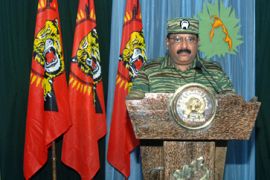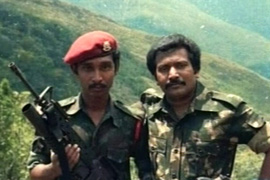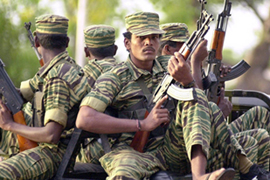Profile: Velupillai Prabhakaran
Tamil Tigers commander led a committed force of separatist fighters.

 |
| Prabhakaran, centre, posed with pilots before a suicide air raid on Colombo in February 2009 [AFP] |
Sri Lanka’s government claims to have killed Velupillai Prabhakaran, the leader of the Liberation Tigers of Tamil Eelam, or Tamil Tigers, bringing an end to the country’s decades long civil conflict.
The rebels, however, have disputed that their leader is dead.
A man with little education from a small fishing village in northern Sri Lanka, Velupillai Prabhakaran founded and led one of the most ruthless and committed separatist organisations the world has seen.
The Tamil Tigers began as a small movement combating what he saw as the injustice and discrimination against the Tamil people.
At its height, the Tigers were a powerful guerrilla force of about 30,000 fighters backed up by a sophisticated worldwide support network for money and arms.
To his followers, Prabhakaran was a dedicated freedom fighter, struggling for the emancipation of his people. Others, however, considered him to be a power-hungry maniac with no regard for human life.
 |
| Prabhakaran, right, groomed the LTTE into a powerful separatist movement [LTTE sources] |
Under his leadership, the Tamil Tigers fought for self determination from Sri Lanka’s Sinhalese majority, declaring their own state of Tamil Elam stretching from Jaffna in the north to Batticoloa in the East.
After the anti-Tamil “Black July” riots in 1983 when an estimated 5,000 Tamils were killed by Sinhalese mobs, many Tamils came to see Prabhakaran as their protector.
He eradicated the inequalities of the Hindu caste system and young men and women flocked to join his ranks.
The Tigers’ leader gave few interviews, but was said to have been fascinated by Napoleon and Alexander the Great.
He was a strong orator and inspired a devoted following among many of his fighting men and women. However, according to some former associates, there was also a ruthless side to his character.
“If someone was against him, he never gave them a chance, he ordered them killed,” Colonel Karuna Amman, a former Tamil Tiger commander, told Al Jazeera.
“A lot of intellectuals were killed by him.”
Cyanide capsule
Prabhakaran himself was reported to carry a cyanide capsule around his neck and encouraged fighters to do the same, saying it was better to take their own life than be captured alive by government soldiers.
 |
| For nearly 30 years, LTTE fighters launched devastating attacks across the country [AP] |
Hundreds of Tiger cadres did just that, in a stark demonstration of loyalty to the man and the cause.
Critics, however, said it was also a clear case of brainwashing.
During three decades of conflict, Prabhakaran’s Tamil Tigers launched a series of devastating attacks on government targets, sapping military morale and taking the lives of thousands of soldiers.
In 2001, the Tigers launched an audacious attack on Colombo’s international airport, destroying half the fleet of the national airline as well as several military aircraft at a nearby base.
Six years later the same base was the target of the Tigers’ first aerial attack, using an aircraft thought to have been smuggled into the country in pieces and reassembled.
Another particularly devastating tactic introduced by Prabhakaran was the use of suicide attacks.
Suicide wing
In the 1980s he created a suicide wing of the LTTE known as the Black Tigers, which went on to carry out hundreds of bombings and killings.
As leader he would always have a final dinner with the bomber the night before they headed off on their mission.
One such bomber is thought to have been responsible for the 1991 assassination of Rajiv Gandhi, the former Indian prime minister.
It was one of the actions that led to many countries declaring the LTTE a terrorist organisation – a move that Tamil critics of Prabhakaran say signalled the beginning of the end of their liberation struggle.
In 2002 after years of bitter fighting, Prabhakaran signed up to a Norwegian-brokered peace initiative.
The ceasefire lasted for four years eventually breaking down following a series of fierce clashes.
Ingenuity
As the war resumed with even more ferocity, the Sri Lankan government increased the size of the army and spent heavily on more weapons.
 |
| The stated aims of the LTTE were to fight for a separate Tamil homeland [AFP] |
The Tigers responded by using their ingenuity to attempt ever more daring and dramatic raids, including one airborne suicide attack on Colombo and a military air base near the capital in early 2009.
Following that attack, the LTTE released a photograph showing Prabhakaran proudly posed with the two pilots about to set off on their mission.
It was one of the last images released of the elusive Tamil Tigers leader, who had not been seen in public for many months.
During the final months and days of the conflict, Prabhakaran was thought to have commanded his forces from the safety of underground bunkers in Sri Lanka’s dense jungle.
In February, government troops captured a two-storey air-conditioned bunker hidden in a coconut grove in northern Sri Lanka’s Mullaittivu district.
The dugout was thought to have been one of Prabhakaran’s main bases.
Pictures released by the Sri Lankan defence ministry purported to show that he had left behind a stuffed tiger, a paintball gun and a bottle of Cognac.